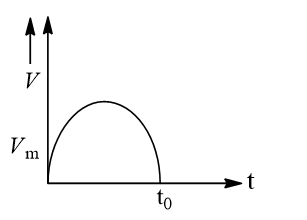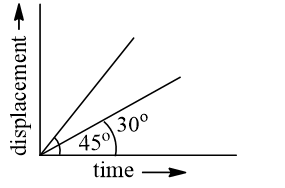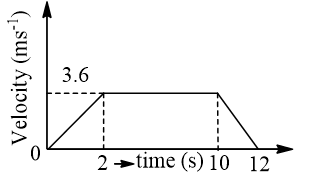Physics-
General
Easy
Question
The variation of velocity of a particle moving along a straight line is shown in the figure. The distance travelled by the particle in 4s is
- 25 m
- 30 m
- 55 m
- 60 m
The correct answer is: 55 m

 m
m
Related Questions to study
physics-
A ball is thrown vertically upward. Ignoring the air resistance, which one of the following plot represents the velocity-time plot for the period ball remains in air?
A ball is thrown vertically upward. Ignoring the air resistance, which one of the following plot represents the velocity-time plot for the period ball remains in air?
physics-General
physics-
The velocity of a particle moving in a straight line varies with time in such a manner that  graph is velocity is
graph is velocity is  and the total time of motion is
and the total time of motion is 

i) Average velocity of the particle is 
ii) such motion cannot be realized in practical terms
The velocity of a particle moving in a straight line varies with time in such a manner that  graph is velocity is
graph is velocity is  and the total time of motion is
and the total time of motion is 

i) Average velocity of the particle is 
ii) such motion cannot be realized in practical terms
physics-General
physics-
Figure given shows the distance –time graph of the motion of a car. It follows from the graph that the car is

Figure given shows the distance –time graph of the motion of a car. It follows from the graph that the car is

physics-General
physics-
The displacement-time graphs of two moving particles make angles of  and
and  with the
with the  -axis. The ratio of the two velocities is
-axis. The ratio of the two velocities is
The displacement-time graphs of two moving particles make angles of  and
and  with the
with the  -axis. The ratio of the two velocities is
-axis. The ratio of the two velocities is
physics-General
physics-
An elevator is going up. The variation in the velocity of the elevator is as given in the graph. What is the height to which the elevator takes the passengers?

An elevator is going up. The variation in the velocity of the elevator is as given in the graph. What is the height to which the elevator takes the passengers?

physics-General
physics-
The variation of velocity of a particle with time moving along a straight line is illustrated in the following figure. The distance travelled by the particle in four seconds is

The variation of velocity of a particle with time moving along a straight line is illustrated in the following figure. The distance travelled by the particle in four seconds is

physics-General
physics-
The time taken by a block of wood (initially at rest)to slide down a smooth inclined plane  long (angle of inclination is
long (angle of inclination is  ) is
) is

The time taken by a block of wood (initially at rest)to slide down a smooth inclined plane  long (angle of inclination is
long (angle of inclination is  ) is
) is

physics-General
physics-
A body is at rest at  At
At  it starts moving in the positive
it starts moving in the positive  direction with a constant acceleration. At the same instant another body passes through
direction with a constant acceleration. At the same instant another body passes through  moving in the positive
moving in the positive  direction with a constant speed. The position of the first body is given by
direction with a constant speed. The position of the first body is given by  after time
after time  and that of the second body by
and that of the second body by  after the same time interval. Which of the following graphs correctly describes
after the same time interval. Which of the following graphs correctly describes  as a function of time
as a function of time 
A body is at rest at  At
At  it starts moving in the positive
it starts moving in the positive  direction with a constant acceleration. At the same instant another body passes through
direction with a constant acceleration. At the same instant another body passes through  moving in the positive
moving in the positive  direction with a constant speed. The position of the first body is given by
direction with a constant speed. The position of the first body is given by  after time
after time  and that of the second body by
and that of the second body by  after the same time interval. Which of the following graphs correctly describes
after the same time interval. Which of the following graphs correctly describes  as a function of time
as a function of time 
physics-General
physics-
A frictionless wire  is fixed on a sphere of radius
is fixed on a sphere of radius  . A very small spherical ball slips on this wire. The time taken by this ball to slip from
. A very small spherical ball slips on this wire. The time taken by this ball to slip from  to
to  is
is

A frictionless wire  is fixed on a sphere of radius
is fixed on a sphere of radius  . A very small spherical ball slips on this wire. The time taken by this ball to slip from
. A very small spherical ball slips on this wire. The time taken by this ball to slip from  to
to  is
is

physics-General
physics-
 In figure, one car at rest and velocity of the light from head light is
In figure, one car at rest and velocity of the light from head light is  , then velocity of light from head light for the moving car at velocity
, then velocity of light from head light for the moving car at velocity  , would be
, would be
 In figure, one car at rest and velocity of the light from head light is
In figure, one car at rest and velocity of the light from head light is  , then velocity of light from head light for the moving car at velocity
, then velocity of light from head light for the moving car at velocity  , would be
, would be
physics-General
physics-
A body starts from rest and moves with uniform acceleration. Which of the following graphs represent its motion
A body starts from rest and moves with uniform acceleration. Which of the following graphs represent its motion
physics-General
physics-
If the velocity  of a particle moving along a straight line decreases linearly with its displacement
of a particle moving along a straight line decreases linearly with its displacement  from 20
from 20 to a value approaching zero
to a value approaching zero  m, then acceleration of the particle at
m, then acceleration of the particle at  m is
m is

If the velocity  of a particle moving along a straight line decreases linearly with its displacement
of a particle moving along a straight line decreases linearly with its displacement  from 20
from 20 to a value approaching zero
to a value approaching zero  m, then acceleration of the particle at
m, then acceleration of the particle at  m is
m is

physics-General
physics-
The graph of displacement  time is Its corresponding velocity-time graph will be
time is Its corresponding velocity-time graph will be

The graph of displacement  time is Its corresponding velocity-time graph will be
time is Its corresponding velocity-time graph will be

physics-General
physics-
The displacement-time graph of moving particle is shown below The instantaneous velocity of the particle is negative at the point

The displacement-time graph of moving particle is shown below The instantaneous velocity of the particle is negative at the point

physics-General
physics-
A body begins to walk eastward along a street in front of his house and the graph of his position from home is shown in the following figure. His average speed for the whole time interval is equal to

A body begins to walk eastward along a street in front of his house and the graph of his position from home is shown in the following figure. His average speed for the whole time interval is equal to

physics-General





